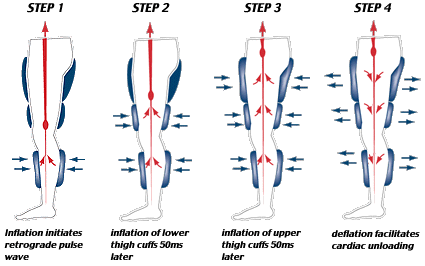Non-invasive therapy for patients suffering with angina pectoris
Enhanced external counterpulsation (EECP) is a non-invasive,
atraumatic procedure that can reduce the symptoms of angina
pectoris, presumably by increasing coronary blood flow in ischemic
areas of the heart. The beneficial effects of EECP on perfusion of
the ischematic myocardium in patients with coronary artery disease
appear to be sustained between treatments, and may persist long
after completion of a course of therapy.

The technique involves the use of the EECP Device to inflate and
deflate a series of compression cuffs wrapped around the patient's
calves, lower thighs, and upper thighs. Inflation and deflation of
the cuffs are modulated by events in the cardiac cycle via
computer-interpreted ECG signals. During diastole, the cuffs inflate
sequentially from the calves proximally, resulting in augmented
diastolic central aortic pressure and increased coronary perfusion
pressure. Compression of the vascular bed of the legs also increases
venous return and cardiac output. Rapid and simultenous
decompression of the cuffs at the onset of systole permits systoic
unloading and decreased cardiac workload. In the treatment regimen
established to date, patients are treated with EECP 1 or 2h daily
for a total of 35h. At the start of treatment, external compression
is progressively increased, as needed, to raise diastolic pressures
gradually.
Finger plethysmograph is used to monitor correct timings. The
concept of counterpulsation is based on a favourable response of the
left ventricle to reduce arterial pressure during the systolic
period. Several investigators demonstrated good correlation between
oxygen consumptin of the left ventricle (LVO 2 ) and pressure time
(variously referred to as Tension Time Index (TTI) or pressure time
per minute (PTM).
These indices have been found to correlate with maximal cardiac
oxygen consumption under circumstances of constant cardiac
contractility and ventricular volume. The heart can be rested, and
its demand for oxygen reduced, if left ventricular pressure can be
reduced. However, effective perfusion pressure must be maintained to
meet the metabolic needs of the body. Under circumstance of
decreased systolic pressure, diastoic pressure must be increased in
order to maintain effective perfusion. This requires a system that
can be synchronized and phased with cardiac activity.
Studies of the haemodynamic effects of counterpulsation have
revealed that several factors give this modality the potential to
assist patients with low cardiac output syndromes.
• Counterpulsation increases the stroke volume per unit work and;
therefore, the efficiency of the left ventricle. Either the left
ventriclar pressure and PTM (pressure time per minute) are reduced,
or the cardiac output is increased, or both.
• Diastolic perfusion pressure and the ratio of the mean diastolic
pressure to the mean systolic pressure are increased.
• Coronary flow increases preferentialy with the distolic pressure
since coronary vascular resistance is minimal during cardiac
diastole.
• The coronary collateral flow to ischemic regions of the myocardium
is increased.
• Modification of the pulse pressure distribution in the aorta
favours increased mean arterial pressure and; therefore, flow to the
vital organs.
In studies to date, therapy with EECP has been well tolerated by all
patients enrolled. No patient withdrew after enrollemnt, and there
have been no reported complications. Patients should not experience
pain during treatment with EECP. Discomfort from the pulsatile
movement and pressure on legs and buttocks may be eliminated or
minimized through use of suitable protective clothing, such as
tights or bicycle pants worn during treatment.
Conclusion
Based on observed response in clinical trials, therapy with EECP can
offer symptomatic and clinical relief in patients with angia
pectoris, including reduced need for antianginal medications,
reduced frequency and intensity of chest pain and increased exercise
tolerance as well as immediate and sustained improvement in
myocardial perfusion of ischemic areas. As a result of symptomatic
and clinical improvements, patients have reported an improved sense
of well-being and overall imporvement in quality of life. Treatment
with EECP offers potential clinical benefits to patients who
generally have ittle else than medical therapy as a recourse.
Studies have shown that treatment with EECP imporoves angina
symptoms and perfusion of ischemic regions of the myocardium
(assessed through nucleography) for up to three years following
initial treatment.
|